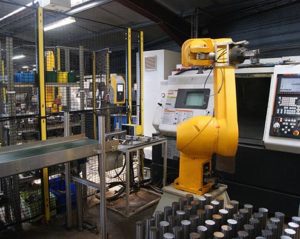Efficiency in Dot Peen Marking Systems Automation

Effective part-marking is indispensable for ensuring seamless component traceability in the industrial manufacturing sector, particularly when dealing with large quantities. Among the various part-marking options available, Dot Peen marking technology has stood out as a preferred solution over the years.
Dot Peen marking machines use electromagnetic or pneumatic force to rapidly oscillate a stylus, creating indents on the part’s surface. Notably versatile, Dot Peen technology adapts well to both manual and fully automated production lines. While commonly employed in manual applications, the flexibility of modular Dot Peen systems allows for an initial portable setup, which can later be seamlessly transformed into an in-line system for integration with fully automated production lines.
The Need for Automation
While dot peen marking is a well-established method of ensuring traceability, it comes with challenges. These include the need for an in-depth understanding of the process, the right direction for the machine, and using the wrong methods for the material the product is made of.
Today’s industries prioritize timelines and the reliable delivery of products. With that in mind, there is an increase in the need for efficiency to ensure deadlines are met. Incorporating automation into production lines, particularly for part marking, has led to significant progress in addressing and resolving efficiency issues.
Technical Aspects of Automated Dot Peen Marking
As marking systems continue to evolve, the benefits of utilizing these systems can’t be ignored. These systems offer avoidance of downtime via their capability to:

- Improve speed and throughput
- Increase consistency and accuracy
- Reduce human error
- Enhance traceability
These systems incorporate innovations applied elsewhere to pair reliability and established problem-solving methods to streamline the part marking process.
Integration with Other Systems
Dot Peen marking systems can be integrated with any system. Portable, in-line, and bench models provide the options needed to maximize the efficiency of your traceability system. Automated options mean better versatility for your dot peen marking and reduced need for human oversight of that aspect of production.
Software Capabilities for Automation
Software has advanced to allow for control of the automation process from outside the facility if you so choose. Meanwhile, the control and adjustment via software means better control and improved marking accuracy.
Customization Options for Specific Industrial Needs
Permanent part marking means reliable part marking for product identification purposes throughout the product’s life span. Both dot peen marking machines and laser marking options offer the versatility to mark a product with a serial number, Datamatrix, logo, or other pattern as required. This then can be used to track the product through its production and installation – and beyond.
For more precise orientation and focus, the laser technology may be helpful. Meanwhile, dot peen marking is a long-trusted method of part marking that provides a mark that impacts the surface via a succession of dots. This method is hard to wear away or otherwise deteriorate, leaving it easy to read for long periods.
From automotive parts and aerospace applications to the oil and gas industry, many industries utilize these marking systems to increase traceability and reliability in part identification into the future.
Trends and Innovations
With current trends in dot peen marking automation, the flexibility and ease of operation only continue to streamline the marking process. Products have reached the market that are portable and not tied to any specific area of the production line. Rather, the use of a secured WiFi connection means the control can be trusted to an operator’s cellphone. In turn, this portable marking machinery can be used in both indoor and outdoor work environments.
The product that requires marking can be of any size and still be within the marking capabilities of the marking system – provided it is made of one of the many materials these systems handle with no issue. These products also come with improved battery life, ensuring an entire day’s work can be completed without requiring a recharge of the unit needed for the marking process.
Considerations for Implementation
For those considering automation for part marking, there are numerous factors to evaluate before incorporating automation. These range from your WiFi connection security level and reliability to the level of training necessary to bring your staff up to speed with this pivot in control in the marking process.
Consider these resources to evaluate your readiness for automation in your marking system:
10 Industrial Part Marking Considerations
The Ins & Outs of Industrial Laser Marking Machines
Dot Peen Marking Machines & Efficiency | Final Thoughts
Dot peen marking is widely accepted as reliable and efficient in providing traceability solutions that are prioritized in today’s fast-moving but transparent society. With this in mind, it only helps to improve that reliability with the incorporation of automation to facilitate the programming and fulfillment of the part marking process.
Before you go…
It’s normal to still have questions at this point. If you are still considering your best next steps, our resource on part marking considerations could also be helpful:


